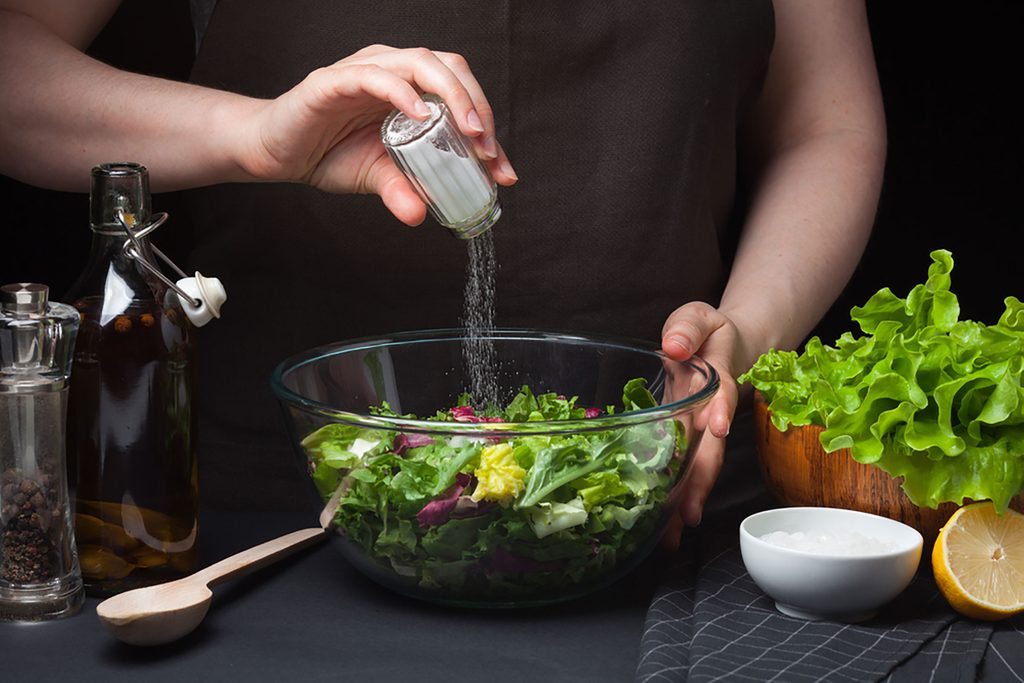Your Risk of Developing Diabetes Goes WAY Up If You’re Eating Too Much Sodium—Here’s Why
Updated: Oct. 03, 2017
Experts debate how bad salt really is, but for people at risk for diabetes the answer seems clear: Cut back or you'll be likely to develop the disease.
 When you think diabetes, you probably think sugar. You’ll notice that the top nine foods for diabetics are all low in the sweet stuff. But clinical evidence has also demonstrated a close link between salt intake and diabetes. A recent study by the Institute of Environmental Medicine found that just increasing your salt intake by a little bit can drive a big jump in your risk of diabetes. (Don’t miss these silent signs of diabetes.)
When you think diabetes, you probably think sugar. You’ll notice that the top nine foods for diabetics are all low in the sweet stuff. But clinical evidence has also demonstrated a close link between salt intake and diabetes. A recent study by the Institute of Environmental Medicine found that just increasing your salt intake by a little bit can drive a big jump in your risk of diabetes. (Don’t miss these silent signs of diabetes.)
The researchers analyzed the diets of 1,136 people at high risk for type 2 diabetes or a form of late-onset type 1 diabetes to a healthy group of 1,379 people. They found that sodium intake was associated with an average 43 percent increase in the risk of developing type 2 diabetes for each extra gram of sodium consumed per day—here are the signs you’re eating too much sodium. That’s about a half teaspoon of salt. For people at risk for the late-onset type 1 diabetes, that half-teaspoon increase in salt drove up their risk of developing the full-blown disease by 73 percent.
“The type 2 group with the highest consumption had a 58 percent higher risk of developing diabetes compared to people with a lower intake of sodium,” highlights Tanya Zuckerbrot MS, RD, NYC-based registered dietician, bestselling author, and founder of The F-Factor Diet.” The late-onset type 1 group again was more vulnerable to salt’s insidious effect: The highest intake group was four times more likely to develop type 1 diabetes than high-risk people who got the lowest amount of sodium in their diet. The authors of the study concluded that there is “an association between sodium intake and type 2 diabetes” and that “high sodium intake may be a risk factor” for the late-onset type 1 diabetes. Though the evidence looks pretty damning where salt is concerned, Zuckerbrot notes that further studies are needed to confirm the findings.
But when it comes to sodium, how much is too much?
“According to the American Heart Association, people should be eating no more than 2,300 mg per day with an ideal limit of 1500 mg per day,” says Zuckerbrot who says that’s it’s very important to realize that more than 75 percent of the sodium consumed by Americans comes from processed, prepackaged, and restaurant foods—not the salt shaker on your table. These foods are also surprisingly high in sodium, too.
“Because one gram of sodium equals approximately 1/2 teaspoon, that 2300 mg of sodium—the entire maximum recommendation—is only one teaspoon worth!” exclaims Zuckerbrot. One of the simplest ways to dramatically reduce the sodium in your diet is to avoid processed, pre-made foods and make your own meals from whole ingredients—make your own pasta sauce from scratch, for example, cook your own rice (don’t use the kind that comes with flavor packets), and cook your own chicken. That way you add the salt, and there’s zero chance you could add as much as the food processors squeeze into pre-prepared formulations.
When you’re shopping, stick to foods with five ingredients or less to minimize sodium. When you have to cross that line, says Zuckerbrot, you can still manage your intake: “The best way to keep track of how much sodium you’re eating is by reading the nutrition labels. The sodium on nutrition labels not only includes the sodium from the salt in the product, but also the sodium from any other ingredient containing sodium in the product (for example, ingredients like sodium nitrate, sodium citrate, monosodium glutamate [MSG], or sodium benzoate). Most of all, remember to be mindful of the serving size of the product.”
Just to give you an idea of how sodium can hide, we asked Zuckerbrot to give examples of everyday foods and their corresponding sodium content.
-
- 1 tablespoon of jam or jelly = 10 mg sodium
- 8 ounces of low-fat milk = 120 mg sodium
- 1 hard-boiled egg = 60 mg sodium
- 2 slices of seven-grain toast = 260 mg sodium
- Fresh fruit = 0 mg sodium
- 12 ounces of plain or flavored seltzer = 15 mg sodium
- 4 graham crackers = 160 mg sodium
- 2 tablespoons of no salt added peanut butter = 10 mg sodium
- 5 ounces of baked salmon = 90 mg sodium
- 1/2 cup of broccoli = 20 mg sodium
- 1/2 cup carrots = 50 mg sodium
- 1 teaspoon mustard = 65 mg sodium
- 1 tablespoon mayonnaise = 80 mg sodium
